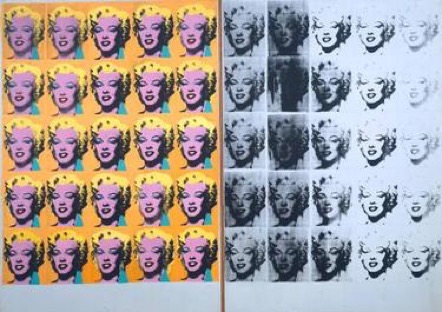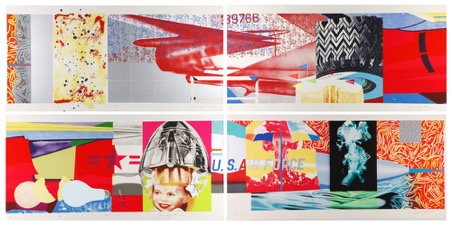This essay analyses the history of Pop Art by researching what it is, how it came to be and identifying its main pioneers. It will look into art works made during the movement and analyse how they were made, why they were made and the artist thought when creating them. As well as this, it will look into why there were not recognised female artists during the time period and if they were ever acknowledged as Pop Artists. To do this a variety of resources will be used from text books to documentaries.
Pop Art was a reaction against Abstract Expressionism. Pop artists rejected the ways of abstract expressionism (Leslie 1997 p.26) because of how loose and morphed the style was, it was hardly recognisable and that was something they wanted to change. Abstract Expressionists didn’t see pop artists as real artists because of how they often got other people to do their work for them largely because of mass production.
It was said to have been created in the 1960’s in America but according to the BBC Documentary Soup Cans & Superstars (2015) it is not necessarily true. It actually first began in Britain in the fifties when it wasn’t formally defined or recognised as a movementHowever even though it started there it mostly became known in the 60’s in America due to the artists most known for the art movement being based there and it’s a bigger country than the UK therefore it has a wider audience as well as the fact that it is a country that people look to more than the UK, at least in those days.
Each Pop Artist have their own unique ways of creating Pop Art has many different looks to different people and that comes across in the variety of artists the art movement has. At the same time, each artist uses the distinct features that you would identify as a Pop Art piece of work. For example, it’s easy to understand what an image is because it’s clear and colourful. A common feature of Pop Art is the bright colours used to make a distressed image seem happy. The bright colours are also ideal to be used in works of mass production such as advertisements and branding.
Works created for this movement usually had some a deeper meaning buried in a mess of colour, playfulness and popular imagery for the time. They were like mirror images of the world. The Documentary film by the BBC (2015) supports these claims. Certain imagery used in the art were images that weren’t particularly of something positive, like an electric chair for example, but because of the bright colours an electric chair would become something that didn’t seem as daunting as it is because of the colours and made it really look beautiful.
In the sixties when it became huge in America, to the general public it was thought that Pop Art was pointless and lacked substance; that it didn’t have any point to it and to other artists they criticized Pop Art for some of the questionable images used with such a nonchalant type manor. “Modernist critics were horrified by the pop artists’ use of such ‘low’ subject matter and by their apparently uncritical treatment of it.” (n.d. Pop art – Art Term).
In different parts of America there were a handful of people who were walking on the same art plane but each of them weren’t aware of the others until later on. However, those selections of people have become some of the most known names for the art movement and in a sense, the pioneers without intending to. Well-known names associated with the Pop Art movement are Andy Warhol, Roy Lichtenstein, James Rosenquist and Claes Oldenburg.
Possibly the most known artist is Andy Warhol. At the time, he became one of the most popular artists in the world due to the nature of the work he created. He was obsessed with celebrities and the lifestyle that came with the title and he craved the attention. Even though Warhol was at heart a very shy person and was uncomfortable around other people he still sought out the life of fame because he craved the validation that being famous, a celebrity, gave him. Money was also a very important thing to him; it was what drove him because it was something that gave him the power to live the kind of lifestyle he wanted to live. (Ketner 2013, p.8)
He was quoted saying, ‘his favourite work was his Campbell’s Soup Can’ and that he ‘should have kept doing those’ (Ketner 2013 p.60). On the other hand, repetition is one of the key elements of Pop Art. It was the Campbell’s soup that leads him into discovering silk screening and therefore was able to mass create work. This led him into using the technique for his Marilyn Monroe art work later on.

(Marilyn Diptych, 1962)
Arguably, Warhol’s most memorable piece that he created is likely to be the Marilyn Monroe repeated portraits that were created after she died of an overdose in 1962. Marilyn was an idol of his and because he often used death frequently in his work, it allowed him to incorporate both of his obsessions into one or rather two side by side images, one in colour and one without colour to show the contrast between the living and the dead. The work shows that you can make the most of your life, you can be rich or you can poor, famous or mundane, but in the end, none of us can escape death. (Ketner 2013 p.66)

(F 111, 1974)
Another famous Pop Artist to look into could be, James Rosenquist who started out as a sign advertisement painter. Painting these huge billboards taught him how to paint even better, ‘It was like art school’ he said in the BBC (Soup Cans & Superstars, 2015) Documentary. However, he hated doing those advertisements because he was just painting images that meant nothing. That’s when he started producing other works of his own by taking that painting knowledge and using reference imagery to help him paint his own. They were often a collage of images. Some looked like they had no connection whatsoever but they really held all ‘the empty promises capitalism provides’.
One specific example of his work is the F 111 plane that was inspired by the Vietnam War (1955-1975). At first glance, it was chaos and it’s just a bunch of random images collaged together in some random way, but upon further inspection, it would be noticed that it is composed to look like a full airplane even with all the interruptions of different imagery throughout the piece. It is a really long painting made up of 23 sections and was 86 feet in length as the documentary by the BBC (Soup Cans & Superstars, 2015) confirms. It consisted of images of war or images as metaphors of war for example the umbrella looks like a bomb exploding. He was inspired to create it because he was tired of the people paying taxes just for their taxes to go into producing weapons and he took his anger of the production of weaponry out in art and it became his masterpiece. When he was told that when people think of his work they say it’s ‘a piece of protest art’ he said ‘I hope so. I like that.’ (Soup Cans & Superstars, 2015).
Pop Art was a very male dominated art movement. Throughout history when researching famous artists for the movement the main people who appear in searches are male. Any female artists of the time didn’t get as much attention because of the gender inequality that was still going on and was never acknowledged.
It wasn’t until later on when the women’s rights movement started that female Pop Artists began to be recognised. The women featured in designs and the women who created art started to be seen as more than just sex objects but by no means were they completely seen that way and were seen for more than just their features, they were very much still seen as sex objects but just a hint of changes in small amounts. Even though female artists began to be acknowledged a bit more, they still weren’t fully accepted as real artists which is why the main pioneers for Pop Art are predominantly male. Ironically, it was the women portrayed in art created by men who provided change for women because the men were stuck in their old styles and wanted to created something fresh and different to the normal. (Candace Mortier, 2016)
The art movement became more commercial and advertisement focused because of how widely seen the products or things using the art would be seen on posters, products and signs. To make so many of the same paintings though became very repetitious. Andy Warhol himself agreed that it was repetitious Pop Art being repetitious in a recorded interview in 1964 (I Love Warhol, 2015). Pop Artists used the things around them to inspire them and therefore things that seemed repetitious encouraged them to make things similar. Therefore, upon seeing advertisements around them it was only natural for it to inspire them to take it on for themselves.
The very first use of the word pop to describe Pop Art work by Richard Hamilton when it had no name was by Lawrence Alloway the critic by using the term ‘mass popular art’ which then was shortened to Pop Art (Staff 2015 Lawrence Alloway.).
The word pop being an abbreviation of popular means it’s always current and relevant so in a way popular never dies. The things that are popular die, but popularity itself is still, popular. It’s that which leads you to believe it never truly died, because popular things are everywhere even more so today because of social media and the internet being accessed every day, at all times on a much larger scale. It was in 1968 when there was a murder attempt on Andy Warhol’s life by Valerie Solanas, which many thought he died from but was proven later that he actually survived, that began the end of the Pop Art movement. (BBC, 2015) But it never really died.
Examples of Pop Art being used today would be the comic book stylings of Roy Lichtenstein are still used today within the comic books that are still being produced and are still popular and you see it a lot when it’s something related to superheroes. There are music videos out there such as Rock N Roll by Avril Lavigne and the lyric video for Waiting for Superman by Daughtry. You see Pop Art as a heavy influence a lot in video games such a Grand Theft Auto and their multiple game options. They’re colourful and bright, they’re about death, money, women, and they’re include a lot of things that Pop Art is known for.
Pop Art is good because it lets you see the beauty in something you may not have noticed before or it lets you express disasters and hard times in a much more pleasant way. The brightness of Pop Art enlightens something inside that gives the feeling of hope in times of trouble and it gives that small spark of lightness in the dark that will come when it’s needed most and that’s what is beautiful about it.
The aim of this essay was to critically analyse the Pop Art movement. Overall this study shows the pros and cons of the Pop Art movement such as how it affects people with its bright colours and makes people feel hope in times of need but also its underlaying tone of death, obsession and sexism. The essay extends our knowledge of who, when, where and why the art movement started and its influence of today. It is clear that Pop Art still shows itself in all kinds of media from videos games to music videos and further. Overall, this study strengthens the idea that Pop Art never really died but in fact just faded a little into the background to make way for other movements and trends, but very much still being a part of art until this day and even through other art movements such as Postmodernism.
Bibliography
Rosenquist. J. (1974) F 111. Retrieved from http://www.seniorandshopmaker.com/exhibitions/2014/8/15/james-rosenquist-f-111-south-west-north-east-and-drawings-from-the-70s
I Love Warhol. (2015, April 22). I Love Warhol: Andy Warhol Interviewed on Pop Art in 1964 . Retrieved from https://www.youtube.com/watch?v=jr8NE7r1szU
Ketner, J. (2013). Andy Warhol. (1st Ed.). London, United Kingdom: Phaidon Press
Lawrence Alloway. (2017). Retrieved from https://www.guggenheim.org/blogs/checklist/lawrence-alloway
Leslie, R. (1997). Pop Art: A New Generation of Style. (1st Ed.). London: Tiger Books
Pop art – Art Term | Tate. (n.d.). Retrieved from
http://www.tate.org.uk/art/art-terms/p/pop-art
Soup Cans & Superstars. (2015). BBC. 4.
Candace Mortier. (2016, December 31). The Exploration of Pop Art: Documentary by Candace Mortier . Retrieved from https://www.youtube.com/watch?v=no7Mjf02Ge0
Warhol, A. (1962). Marilyn Diptych. Retrieved from https://www.khanacademy.org/humanities/ap-art-history/later-europe-and-americas/modernity-ap/a/warhol-marilyn-diptych
